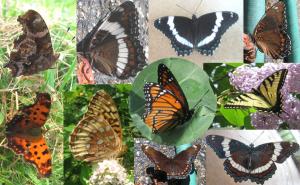Sale on canvas prints! Use code ABCXYZ at checkout for a special discount!

NEWSLETTER August 2010
Greetings from the mountains of western Maine!
August has been all about butterflies. I have heard other people around here say, too, that they have never seen so many butterflies in a summer. I have been capturing and releasing, photographing, and drawing butterflies all month long. I even found a mysterious, one-of-a-kind butterfly, which I will tell you about.
I did colored pencil drawings that I did of two familiar favorites, the viceroy (the orange one) and the white admiral (black with a white stripe). On this site, they are posted with the artwork.
One thing that really puzzled me about my photographs was how many legs I was seeing. I thought that insects have six legs, and a butterfly is an insect, so a butterfly should have six legs, right? But I could not find more than four legs on these creatures in any of my photos.
The explanation? There is a whole family of butterflies called the brush-footed butterflies (Nymphalidae) that have only four walking legs. The pair of legs closest to the head is so small as to be unnoticeable, and is used for jobs like cleaning the eyes. The brush-footed butterflies include many of our showiest and most familiar butterflies, such as the monarch, viceroy, admiral, painted lady, and fritillaries. So my photos were accurate and my drawings are also—four-footed butterflies.
The viceroy (Limenitis archippus) is very similar to the monarch butterfly, but it is a bit smaller and has a slightly simpler pattern on its wings. Like the monarch, it is highly distasteful to predators. This is called “Mûllerian mimicry,” meaning that both species are harmful.
The white admiral, Limenitis arthemis, also exists in a very different coloration called the red-spotted purple. These were once thought to be two distinct species. But in terms of shape, behavior, and natural history, they are identical, so they are now classified as the same species. They are both widespread in the United States, with the admiral occupying the northern area and the red-spotted purple the southern. But there is an overlap zone between about 40° and 46° N., from southern Minnesota east to New England, where butterflies that look like a cross between the two are found. And thereby hangs a tale.
I was walking out of the house last Friday, after spending the morning drawing a white admiral butterfly, and I saw two butterflies on an apple that had fallen from the tree by the front walk. One was a white admiral. The other was slightly smaller and richly colored, but unfamiliar. The strange thing was that I recognized the pattern on the edge of its wing. It was the one that I had just been drawing. This obliging butterfly was so interested in its meal that I was able to go back in the house, get my camera, and snap a few close-up shots of it before it took off. It apparently has had a rough life; a large chunk was missing out of its left hind wing.
I tried to identify this mysterious beauty, but it was not anywhere in my field guide or in the internet resources I could find. But I did find a link on the Butterflies and Moths of North America site for help in identification. I fired off my questions and the photos to them and had a reply in short order. And sure enough, what I was seeing was what is called an “intergrade” between the admiral and the purple. In other words, a one-of-a-kind butterfly, neither admiral nor purple, but a stunning cross between the two. What a wonderful end to my butterfly summer!
I have attached a file of a montage of some of my butterfly photos for you. In it you will see (clockwise around the edge, from the upper left) a comma, a white admiral, the white admiral from the top, the mystery butterfly, a tiger swallowtail, the white admiral from the underside, the mystery butterfly again, a fritillary (possibly a great spangled fritillary, but I am not sure), and the comma from the topside. The butterfly in the circle is a viceroy. I give you permission to print or reproduce this image as you choose. I am using it as my desktop wallpaper, myself.
For more information on “Swift River Treasures,” my artmaking process, or recent work, or to check out my blog, see my website at http://betsy-bell.artistwebsites.com/. Here you can order prints of my work, and have them matted and framed if you choose, courtesy of Fine Art America’s great print-on-demand service. I also offer greeting cards, either single or in packages.
Art is the fatal net which catches these strange moments on the wing like mysterious butterflies, fleeing the innocence and distraction of common men. (Giorgio de Chirico, from “On Metaphysical Art,” 1919)
Thanks for joining me in the journey. I hope that you enjoy looking at the art as much as I have enjoyed making it! I would love to hear from you, too, so please do reply with comments.
Betsy